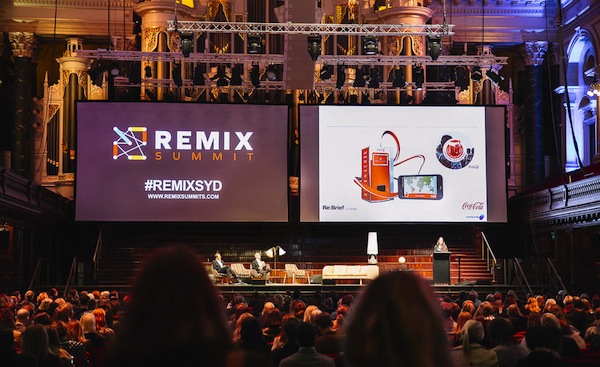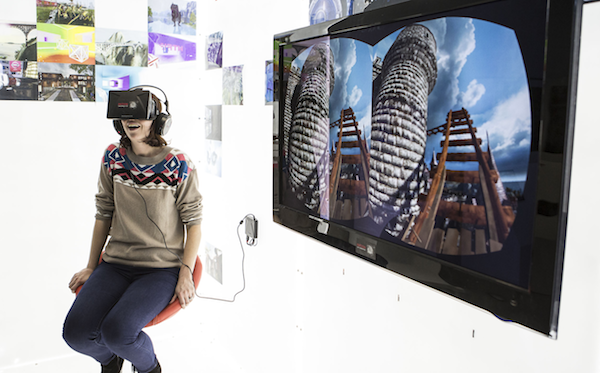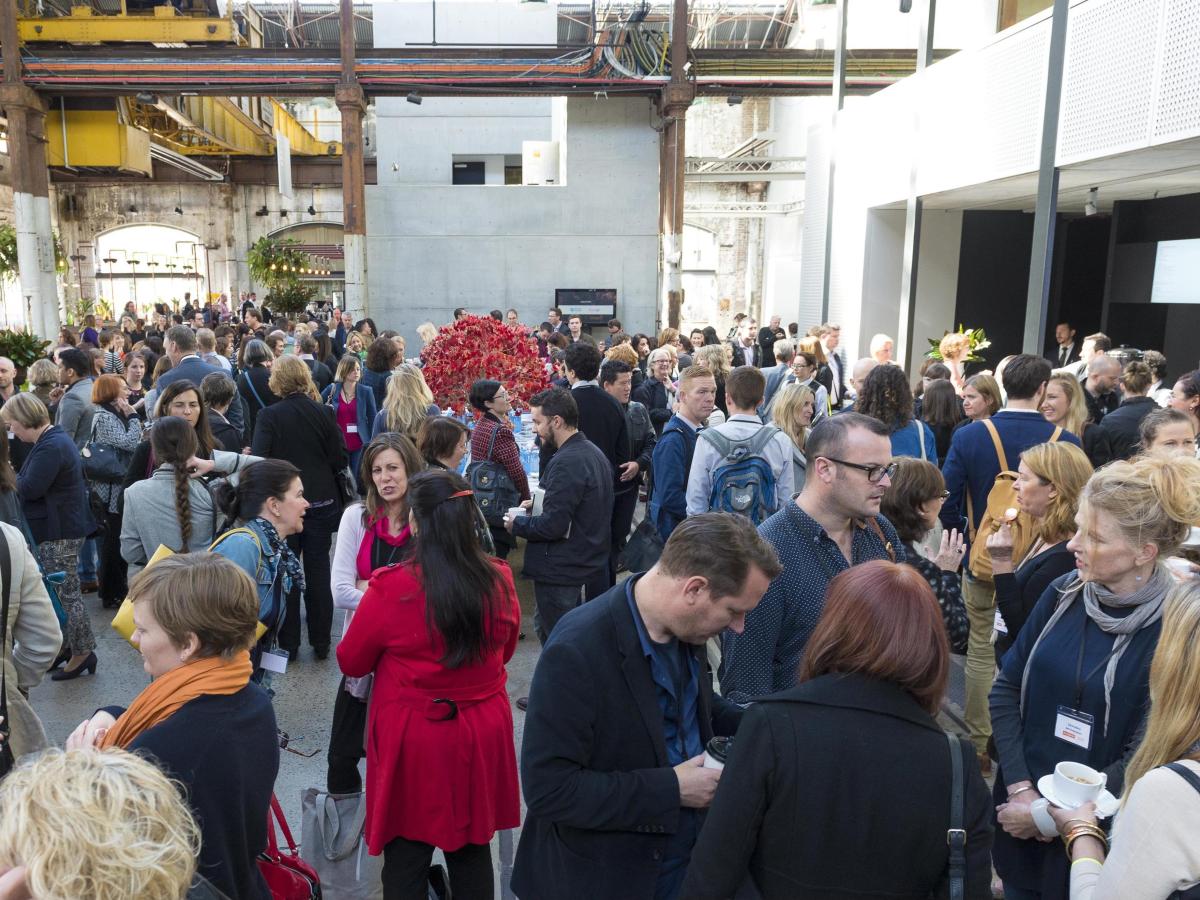Last year’s REMIX delegates networking; supplied
Put a bunch of technologists, entrepreneurs, brands, policy makers, artists and cultural organisations in a room together for two days and what do you get? Simply, a picture of our future.
REMIX is that picture: a platform that rewrites how we connect and consume across sectors, from a grass roots level to global success.
This June, over 100 creative entrepreneurs from across the world will be speaking at Sydney’s Town Hall at the third REMIX Sydney Summit. At the heart of this top-drawer chat-fest is the start-up mentality – the idea of creating something out of nothing.
‘An entrepreneurial approach uses surrounding structures, alliances and strategies to leverage the assets you already have, rather than being restricted by financial constraints,’ said REMIX Co-Founder Simon Cronshaw.
Cultural or creative entrepreneurship is not exclusive. It is a win-win scenario and everyone has the opportunity to come to the table.
Cronshaw continued: ‘The consumption of culture is expanding across the globe and it is becoming more grass roots. I think, like anything, trends have to be working in your favour so this is a great opportunity. And now is a good time to consider new models for audience engagement and revenue generation for cultural organisations.’
Take the experience economy, where consumers demand ‘real’ experiences – the cultural sector has been at the forefront of driving demand for this trend, yet remains barely visible on mainstream aggregator websites that market unique experiences. Now it is time to venture a little further afield.

Breaking it down at the REMIX Ideas Brewery; supplied
I’m not an entrepreneur, am I?
Cultural entrepreneurship is a label that has increasing garnered traction over the past decade – but the shift that we are noticing now is that it is no longer exclusive to big money and start-ups.
Australia has a phenomenal number of start-ups, and they are ripe for harvesting through innovative partnerships.
Fellow founder of the REMIX project, Peter Tullin told ArtsHub: ‘There is a raft of individuals today using emerging technology, and new business models, who are borrowing ideas from other sectors and developing opportunities that repackage culture.
‘What we are seeing is that entrepreneurial strategies make it possible for individuals and smaller organisations to build scalable creative enterprises,’ he continued.
Technologists can live anywhere in the world, but they want to be located within broader creative ecologies and suddenly you – as cultural organisations – are a part of that environment. That is good news for our sector, but we need to lay out the welcome mat if we want to ride this wave.
‘In a recent research piece we undertook for the City of London, we concluded that growth cities in the tech space are finally getting beyond the simplistic approach of trying to replicate the Silicon Valley model – look at New York and London.
‘Rather than everybody wanting to replicate “the tech cluster”, they are turning to broader creative ecologies and over the last 10-years they have become the second and third largest startup economies respectively. When you look closely, it is no surprise that London’s tech scene is centred around East London which has long been a grass roots artistic and creative hub,’ said Tullin.
Tullin mentioned Governors Island, New York – a project that has been ten years in the making and is said to rival New York’s celebrated High Line and has garnered a reputation as the place “where all the cutting edge art is happening”.
‘They have taken a post Silicon Valley approach. It is now about building creative clusters, and that encourages the tech companies to come in and build infrastructure. It is about getting beyond our cities. It is all driven out of a vibrant cultural infrastructure,’ Tullin explained.
Leslie Koch, President for The Trust for Governors Island will be presenting at this year’s REMIX Sydney Summit.
Cronshaw added: ‘The arts sector has grown in confidence and is embracing technology more and looking to collaborate. So much is happening in this space now. REMIX is throwing wood on that fire.’
He continued: ‘We are asking big social questions as nations. We have been in this a few years now and the more we observe the current trends and conversations the bigger the ripples are. There is great grass roots stuff bubbling up effecting change.’
‘The session I am most excited about this year is the future of communities. We have the Director of Change.org, Karen Skinner talking about mobilizing communities alongside Kate Torney, CEO State Library Victoria. I love those juxtapositions where one community can learn from another. They would not necessarily be in the same room but will be at REMIX,’ said Tullin.

Image supplied
Strategies for success
In the arts and culture sector we are hardly short of ideas. What we struggle with is identifying strategies for their delivery – turning those ideas into new commercial revenue and audience growth.
Cronshaw explained: ‘There is so much incredible content out there. For me, the big question is supply and demand on each side of equation. On one side of the fence you have deeply committed cultural organisations and assets. On the other side you have huge consumer demand for the sort of thing we’re experts at in the creative sectors. The problem is that bridges between the two are not yet fully developed.
‘We know audience demand is becoming more and more immersive, more engaged. So REMIX is about looking at those other models – those other industries – to find better bridges between these worlds and repackage and rework them when we think of culture and arts.’
It is also about introductions. Alongside the keynote presentations are break out collaboration spaces such as our Ideas Brewery, coffee dens and parties, where Tullin says the real connections are made.
‘REMIX was inspired by the concept of the enlightenment coffee house where the scientists, merchants and artists discussed the issues of the day, leading to breakthrough ideas that shaped the modern world – REMIX is a contemporary platform where artists, filmmakers, technologists overlap in casual conversation – chance meetings with great outcomes’.
One such partnership formed at 2015 REMIX was between Microsoft – which gave a talk that included a feature on Skype’s new simultaneous translation technology – with the Australian Museum who used this to contribute to a project for preserving Indigenous language.
Similarly, the Chief Digital Officer at the Metropolitan Museum (New York) met the founder of the company Blippar at the previous REMIX New York and used their technology to produce animations for Van Gogh paintings in their Collection.
‘The REMIX model is half from culture sector and half from the technology-media-business sector, which opens to a wide range of collaboration opportunities, and we find it really works,’ said Tullin.
Among the presenters at 2016 REMIX Summit are: Chris Michaels, Head of Digital at The British Museum; Leslie Koch, President for The Trust for Governors Island, New York; Jon Penn, Managing Director BBC Worldwide; Damian Totman, Global Creative Director, Bloomberg; Grant Baxter, Head of Brand Strategy Twitter; Lindsay Miller, Managing Director Dubai Design District. View full list of speakers
Has innovation become a dirty word?
The word innovation has been thrown around a lot in Australia over the past twelve months, largely in the wake of repackaging funding opportunities in the arts sector. Has the idea of innovative become tainted, or been run off course by bureaucrats?
Cronshaw said: ‘We use worlds like “cultural entrepreneurship” interchangeably with “innovation” and the reason that we do that is entrepreneurship, at its heart, is challenging, inspiring and engaging.’
‘Cultural entrepreneurship is sometimes also out of necessity. With the European reduction in arts funding – like Australia – people have to be more entrepreneurial in how to take their product to market and tap into new opportunities and grow audiences’ added Tullin.
‘While we are by no means immune to economic pressures, cultural organisations should still have the confidence to think big and defy the downturn,’ Cronshaw added. ‘The current levels of innovation are fast-paced, and when you put these trends together, match and remix them, the opportunities are explosive.’
The pair believe that the real skill of an entrepreneur is creating something from nothing – just doing the bare minimum to get the viable product out to users and then test and refine from there. That almost sounds like the modus operandi of the culture sector – pull something amazing out of the hat with your hands tied.
‘We see entrepreneurship about connecting at a really deep level, and that is about going back to basics and to understand who you engage with and how to engage with them better.’
Tullin said it is all about taking the art and culture experience to where consumers are looking rather than waiting for them to come to you.
REMIX opened a co-working space for the creative industries 3-years ago in Shoreditch, London and have been advising ACMI on the new ACMI X project over the last year. He enthusiastically spoke of the benefit of new types of infrastructure to support innovation in the cultural and creative industries.
One creative enterprise in their London space is Digventures, is a social enterprise set up by cultural entrepreneurs who specialise in crowd-funding major archeological digs. ‘In a world where funding a dig is increasingly difficult they took it away and repackaged that model for hipster urban audiences wanting an alternative “dirty weekend”. Tapping into the experience economy with clever branding works.’

Trendscouting at REMIX; supplied
Trend Scouting
REMIX has a global reputation as being a trend scout – seeking out the change-makers at the edge who are destined to shift the market dynamic.
Cronshaw said: ‘There is something important about hearing from innovative industry players – how we consume things, how we shape the world and how we break down walls.
‘Sometimes ideas come from the perspective of knowing what you don’t know. And only then, through exposure to innovative thinking, can you start to develop your own new strategies and business models; to ask “who are the collaborators I could be working with?” These are exciting times and REMIX throws open that door.’
It sounds a little like a mosh pit of ideas. Tullin said: ‘More often than not the people in the audience are as interesting as the people on stage. The conversations at our ideas Brewery is the real site of collaboration and bridge building.’
The exciting part is that you will definitely work away from REMIX with a new strategy, or a new approach that will liberate your thinking and your business … what that will be is the great discovery to be had.
REMIX Summit will be presented at Sydney Town Hall 2-3 June 2016.
ArtsHub readers can access a special discount of 25% off ticket prices by using promo code artshub (lowercase) at checkout on www.remixsummits.com/syd





